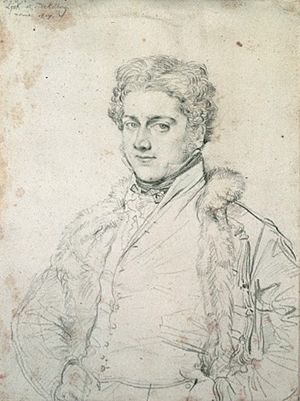Royal Gold Medal facts for kids

The Royal Gold Medal is a very important award given every year for architecture. It's like a special prize from the British monarch (the King or Queen of Britain) through the Royal Institute of British Architects (RIBA). This medal celebrates people or groups who have made a huge difference to architecture all over the world. It's not just for one amazing building, but for a whole lifetime of great work.
Contents
What is the Royal Gold Medal?
The Royal Gold Medal is one of the most respected awards in the world of architecture. It's given to architects, or sometimes other creative people, who have shown amazing skill and vision in their work. The award recognizes their lasting impact on how we design and build things. It's not about what's popular right now, but about a long history of excellent design.
Who was the first winner?
The medal was first given out in 1848. The very first person to receive it was an English architect named Charles Robert Cockerell. The next year, in 1849, an Italian named Luigi Canina won it.
Famous winners over the years
Many famous architects from the 1800s and 1900s have won this medal. Some well-known names include Frank Lloyd Wright (who won in 1941), Le Corbusier (1953), Walter Gropius (1956), and Ludwig Mies van der Rohe (1959). These architects changed how we think about buildings and cities. People from any country can win the award.
Who Else Can Win?
You might think only architects win the Royal Gold Medal, but that's not always true! The award also celebrates other talented people who help shape our built world.
Engineers and their impact
Sometimes, engineers who are super important in making buildings come to life receive the medal. For example, Ove Arup won in 1966, and Peter Rice won in 1992. These engineers helped build some of the most amazing structures of the 20th century.
Writers and thinkers
People who write and think deeply about architecture have also been honored. This includes scholars like Sir Nikolaus Pevsner (1967) and Sir John Summerson (1976). Lewis Mumford (1961) and Colin Rowe (1995) were also recognized for their ideas about architecture.
Discoverers and artists
Even archaeologists, who study ancient buildings and cities, have won. Sir Austen Henry Layard (1868) and Sir Arthur Evans (1909) are examples. Artists like Lord Leighton (1894) and Sir Lawrence Alma-Tadema (1906) have also received the medal. In 1999, the city of Barcelona itself won the award, which was a very special and unusual choice!
Recent Royal Gold Medal Winners
Here are some of the people and groups who have won the Royal Gold Medal in recent years:
| Year | Recipient | Nationality |
|---|---|---|
| 2025 | Kazuyo Sejima and Ryue Nishizawa (SANAA) | Japan |
| 2024 | Lesley Lokko | Ghana/Scotland |
| 2023 | Yasmeen Lari | Pakistan |
| 2022 | Balkrishna Vithaldas Doshi | India |
| 2021 | Sir David Adjaye | UK/Ghana |
| 2020 | Grafton Architects (Practice co-founded by Shelley McNamara and Yvonne Farrell) | Ireland |
| 2019 | Sir Nicholas Grimshaw | UK |
| 2018 | Neave Brown | U.S./UK |
| 2017 | Paulo Mendes da Rocha | Brazil |
| 2016 | Dame Zaha Hadid | Iraq/Uk |
| 2015 | Sheila O'Donnell and John Tuomey (Co-founders of O'Donnell & Tuomey) | Ireland |
| 2014 | Joseph Rykwert | UK |
| 2013 | Peter Zumthor | Switzerland |
| 2012 | Herman Hertzberger | Netherlands |
| 2011 | David Chipperfield | UK |
| 2010 | I. M. Pei | China/U.S. |
| 2009 | Álvaro Siza Vieira | Portugal |
| 2008 | Edward Cullinan | UK |
| 2007 | Herzog & de Meuron | Switzerland |
| 2006 | Toyo Ito | Japan |
| 2005 | Frei Otto | Germany |
| 2004 | Rem Koolhaas | Netherlands |
| 2003 | Rafael Moneo | Spain |
| 2002 | Archigram | UK |
| 2001 | Jean Nouvel | France |
| 2000 | Frank Gehry | U.S. |
See also
 In Spanish: Royal Gold Medal para niños
In Spanish: Royal Gold Medal para niños

